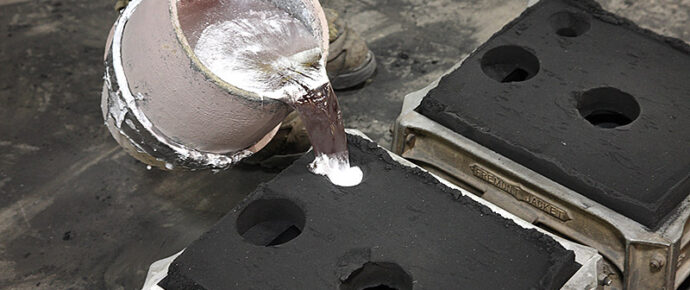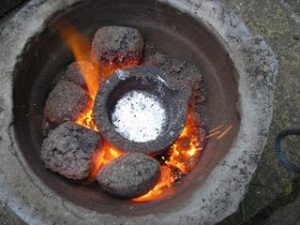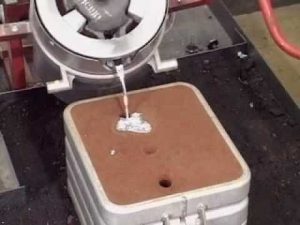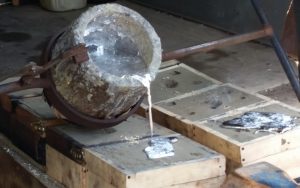Aluminum Casting At Home – DIY Aluminum Foundry & Molds
Have you ever imagined melting aluminum yourself to create small castings? There are many hobby metal enthusiasts who like casting metals at home to either make a special part which is difficult to obtain or to fulfill their creative desires. Aluminum casting at home is so fun and amazing. A simple process can let you create a lot of things only limited by your skill and imagination. Right from designing and pattern creation to mold making, all the processes can be performed easily at home. However, people melting metals at home to create castings should be aware of the hazards involved in the process. Explosions, heat stress and burns are some of the major hazards associated with metal melting at home and if not done carefully, such conditions can lead to injury and even death. Casting aluminum by yourself can be exciting but it is necessary to ensure that you work safely taking proper cautions to avoid any mishaps.
Here, we provide a detailed guide on DIY Aluminum Foundry and Molds to help hobbyist enthusiasts make their dream of casting their favorite metal parts come true. Some of the links on this page are affiliate links and as an Amazon Associate I might earn a tiny amount from qualifying purchases if you end up buying something through one of them.
Page Content Navigation
An Aluminum Casting Foundry At Home
A basic metal casting facility setup in either the backyard or the home for hobby metal professionals to create small metal castings for different needs is referred to as Home Foundry. Such a DIY Aluminum Foundry is different from a commercial foundry as it is usually set up with materials and equipment available easily in the market and is used to carry out simple metal casting jobs. Using simple processes for designing, pattern making and mold making, metal casting hobbyists can create different things easily in home foundry.
The metal is melted at home and poured into the molds and when it has cooled and solidified, it is taken out as a shiny new metal casting. A hobby metal casting professional can create things to be used for special projects, vintage automotive parts, antique restorations and rebuilding old workshop tools. Foundry operations are quite straightforward and you can polish your skills as you practice metal casting at home.
Advantages of a Home Foundry:
- You need not find a source or pay for metal parts which you require for some mechanical device or vehicle.
- If you are going to be making the same parts again in the future (repeat parts) you will already have the mold needed for it.
- When creating a part or component, you can easily make other components by pouring some extra sand.
- A good home foundry can be setup for a fraction of the cost when compared to buying a metal part.
- Most of the foundry equipment is easily available for little or no cost.
Melting Aluminum At Home – Setting Up a Home Foundry
A simple and well-designed furnace ensures ease of operation and efficient metal melting in a home foundry. A furnace can help you maintain your home foundry equipment setup. It is quite easy to construct a furnace using the scrap material found around the workshop. The only material you need to buy is the high-temperature resistant refractory, some brass connectors and brass rod. Using your basic metal working skills, you can quickly make the furnace to complete your home foundry for DIY metal casting.
It is possible to make a DIY furnace to melt aluminum at home foundry. You can use a drum or steel bucket as a furnace vessel and slice its lid and cut a hole in its side near the bottom to accommodate a pipe. To vent pressure you can cut a hole in the middle of the lid. Attach a steel pipe to a coupling and pipe and slide into the furnace.
Due to the extreme temperatures created inside the furnace, it is important to line the floor, inner walls and lid with a refractory material. A good example of such product is Paco Cast. You can mix up the required quantity and follow the instruction on the bag and fill the material at the bottom of your furnace container. You can then fill the wall cavity with the refractory and finally line the lid.
Once the furnace is ready, you can add coals and fire up using fluid. Once they turn white, you can drop your aluminum to start melting it in your own home foundry.
Now, while it is possible to make your own home foundry as you’re making something that is run off of propane (which can explode) and generates a lot of heat, I personally don’t think it’s worth it when you can purchase ready to go foundries for very little money to get started. You can see a pretty affordable one here. And the nice thing about it, is that it’s a kit so you get a crucible and tongs in addition to the foundry – so you’ll be all set.
Aluminum Casting Molds & Mold Making
Though molds can be created using a variety of materials, the process remains the same. The simplest and the most affordable material is a high-quality casting plaster available at an art supply store. It is a good idea to first design the part so that a single-piece, open-faced mold works every time you want to create the part. This gets you rid of the problem of dealing with cope, risers, sprue and alignment. The side of aluminum exposed to the outside forms a layer of crystallized metal on its top but this can be dealt with when the castings are machined.
The sand mold creating process involves use of a metal, furnace, sand mold and pattern. The aluminum is melted in the furnace and then poured into the cavity of the sand mold formed by a pattern. The mold separates along a parting line to remove the aluminum casting. A sand mold is created by packing sand into two halves of the mold. It is packed around a pattern which is the replica of the casting shape. Removing the pattern forms a cavity forming the casting.
Once you have your furnace and molds ready, you can easily melt your aluminum in your home foundry to create castings of your favorite parts without much effort. The best part is that it can be done at a fraction of cost of the original part purchased from the market. We hope this DIY home foundry and aluminum casting guide helps you practice your metal casting hobby and create your home foundry to create parts and components out of aluminum.
If you’re interested in casting other sorts of metal, you can check out our article “Metal Casting At Home – A Getting Started Guide” here.
Please note: you need to make sure that you take every effort possible to keep yourself safe as you mold any sort of metal.
At a minimum you should use the following pieces of safety equipment:
- Respirator
- Heat resistant gloves
- Heat resistant work apron
- Heat resistant leg and foot protection
- Heat resistant arm protection
- Heat resistant face shield
Please keep in mind that these are a bare minimum and that your personal safety should be a priority.





Leave a Reply